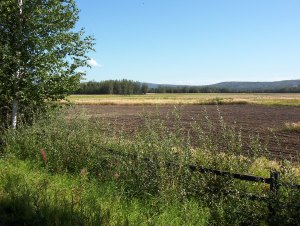
Creamer’s Field Migratory Waterfowl Refuge has a boardwalk through the forested area. The permafrost causes trees to tilt. Photo by Barb Gorges.
Published Sept. 5, 2007, in the Wyoming Tribune Eagle, “A refuge for birds in Alaska.”
2014 Update: Fairbanks advertises unusual winter-time tourist activities, but the birding wouldn’t be so interesting.
By Barb Gorges
Heading north in August runs counter to bird migration.
However, Mark and I enjoyed our trip to Fairbanks, Alaska, 125 miles south of the Arctic Circle.
The city reminded me of Gillette, Wyo., home of hardworking pickup trucks, but with a sprinkling of white Princess Cruises tour buses and spruce trees in undeveloped areas instead of sagebrush.
Fairbanks has the patina of culture and academia thanks to the University of Alaska, but it is also the supply point for folks heading into the bush. There is a pond at the airport with a flotilla of float planes at anchor.
The city population is about 30,000, three-fifths of Cheyenne’s. The Fairbanks borough has 87,000 people spread over 7,631 square miles, compared to here in Laramie County which has 81,000 people in 2688 square miles.
With all that space available, there was a lot of local support for the state to establish Creamer’s Field Migratory Waterfowl Refuge, expanded now to nearly 3000 acres on the edge of the city.
Creamer’s Field was a dairy farm from 1915 until the 1960’s. Now it is known for the annual Sandhill Crane Festival at the end of August, which celebrates the peak of crane and Canada goose migration. We visited too early to take part.
Mark and I, and Mark’s brother, Peter, joining us from Sitka, Alaska, opted for the free, daily, naturalist-led hike across a corner of the old pasture and into the forest. It was a quick way to learn the basics of the local ecology.
Interior Alaska is part of the boreal forest that stretches across Canada and into the northern Midwest and New England. Our guide, an Alaska Fish and Game biologist, said there are only six tree species in this part of the boreal forest: balsam poplar, aspen, paper birch, white spruce, black spruce and tamarack. The numerous willows and alders don’t count.
Permafrost is a building nightmare if you don’t keep it cold. In the forest it naturally creates six-sided potholes and tipsy-looking trees. The refuge has to rebuild the board walk along the boggy parts of the nature trail every few years.
It was too late in the morning for much bird activity in the woods, but in the field was a pond full of ducks that got buzzed by a peregrine falcon.
An offshoot of Creamer’s Field is the Alaska Bird Observatory. It has a permanent banding station, banding every suitable day April until October.
The mist nets are along a nature trail and identified with permanent signs. The station is a semi-permanent tent with steel arches and a plywood floor. There are three processing tables and a crew of employees, interns, college students and volunteers, including children under the tutelage of mentors.
While we visited Aug. 14, an American tree sparrow was the first of its species to be banded in the fall migration already underway. However, it is a migratory bird for Fairbanks rather than a winter bird as it is for us in Cheyenne.
On the board listed as the cool birds of the week were many warblers we see in Cheyenne during migration including yellow-rumped, orange-crowned, Wilson’s and Townsend’s.
The two coolest birds to be banded the week we were there were slightly off-course Arctic warblers. In 16 years these were only the 20th and 21st the ABO had banded. We’re unlikely to see them in Wyoming as they nest in the Arctic and winter in the Philippines!
However, Wyoming does share two famous naturalists and conservationists with Alaska, Mardy and Olaus Murie. They were mentioned more than once in various museums. Several gift shops carried Mardy’s book, “Two in the Far North,” which chronicles her early life in Fairbanks and the couple’s research in the Arctic beginning in the 1920’s. They later made their home in Moose, Wyo.
My list of bird sightings includes two willow ptarmigan—but they might have been rock ptarmigan. They were on the side of the road on the tundra at Denali National Park and Preserve. We also saw five grizzlies, numerous caribou and Dall sheep.
Even though we couldn’t leave the shuttle bus between official stops, our driver didn’t hesitate to make pauses for wildlife photography out the windows.
In Fairbanks, over at Pioneer Park, we saw something unexpected. Instead of begging mallards swimming in the pond at the re-creation of a gold mining sluice, we saw American wigeon. They haven’t learned to beg yet, but they weren’t too shy either.
Our last evening in Fairbanks, I stood out in the driveway of the bed and breakfast about 10 p.m. to admire the blue sky above, and to watch a large V of Canada geese coming from the other side of the Chena River, winging south.
The commentator on the Riverboat Discovery cruise had said that by Halloween Fairbanks would be dark early and the Chena would be frozen solid enough to become a landing strip for small planes equipped with skis.
Because Fairbanks’ high latitude produces extremely long days of summer sunshine, 45 pound cabbages, incredible flower gardens and lots of food for insectivorous birds, I think migration is a great strategy.
However, the chickadees, ravens and gray jays tough out the minus 45-degree winter temperatures, just like the remarkable people we met who choose to live in interior Alaska.

